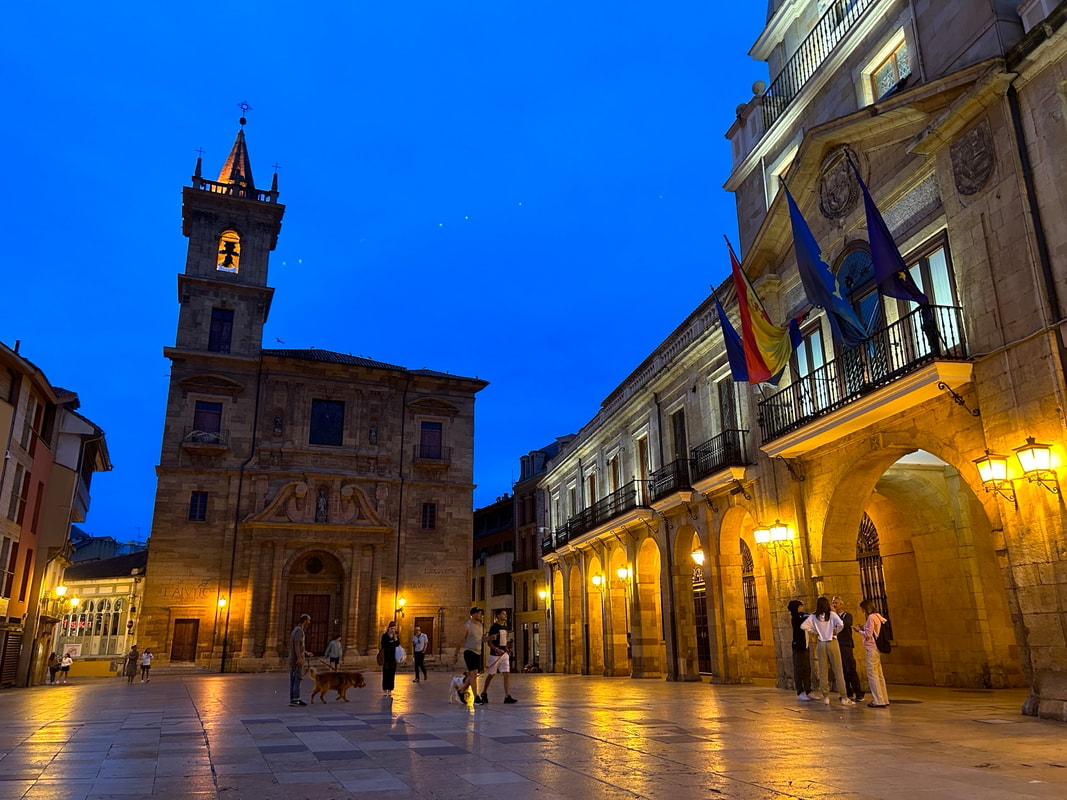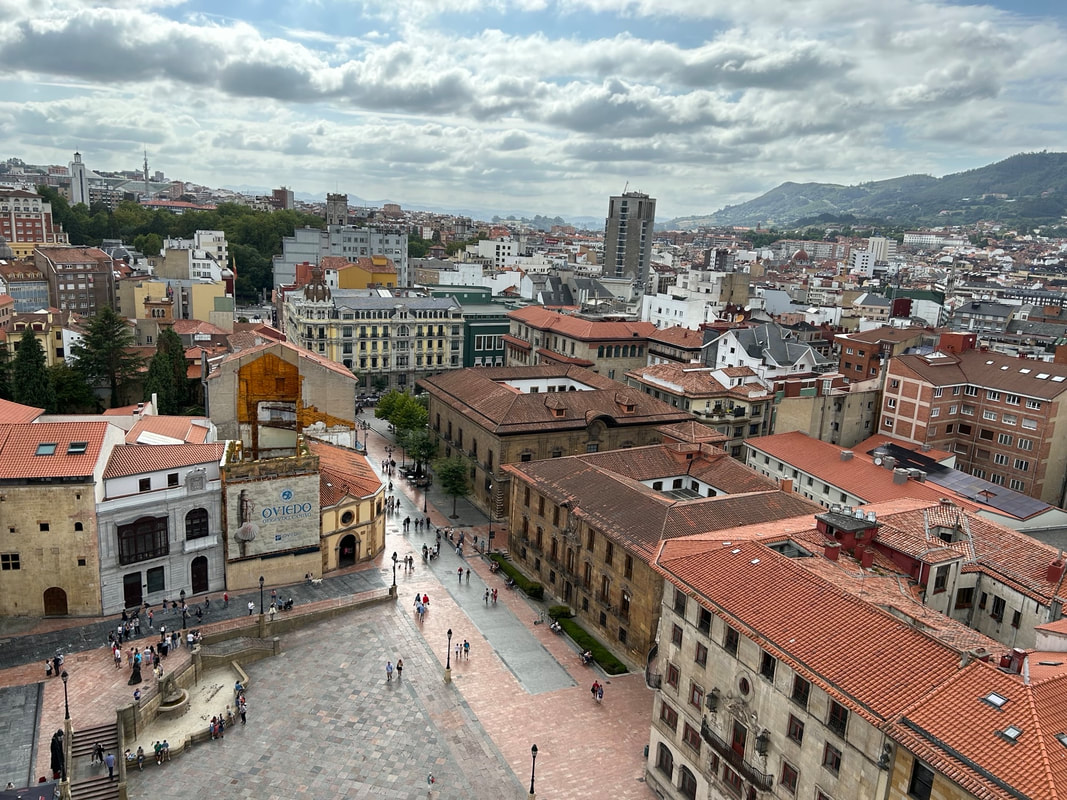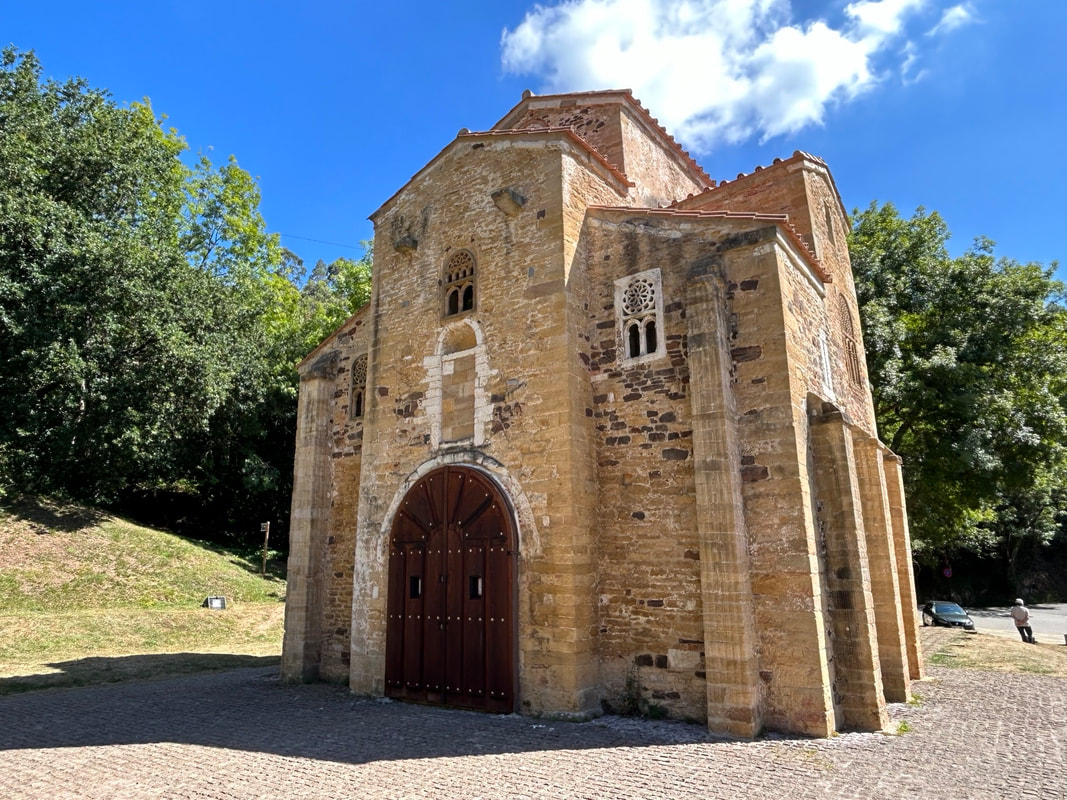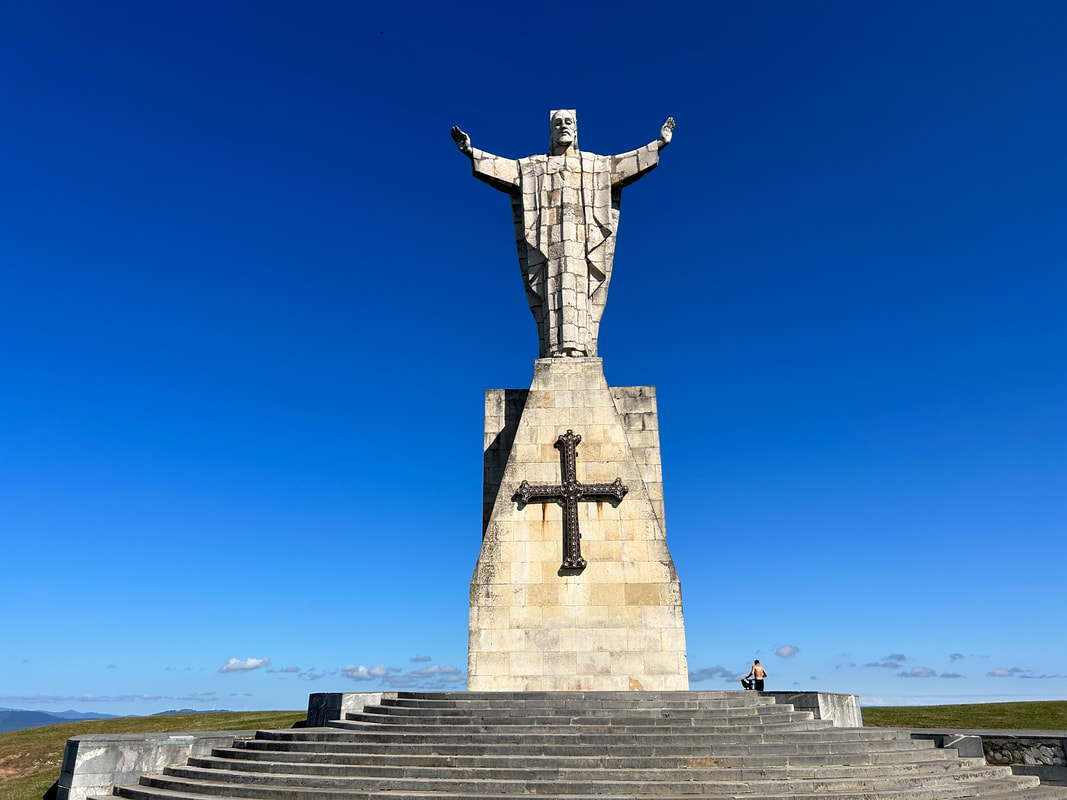SummaryAirport Security ***** Reception of locals **** Cost: £££
The real SpainI've been to many parts of Spain over the years, but an area I haven't explored previously is the northern coast. It's a part of Spain that isn't as touristy as other regions, particularly the south and the east, but I quickly found out that missing the north is missing a big part of Spanish culture. It's more than just a different part of Spain, for locals in one northern region, Asturias, this is the real Spain. When the Arab and Berber armies ruled the Iberian Peninsula, this was the one region that was only briefly conquered - largely because of its geography, surrounded by large hills and mountains. It was from this small region that the reconquest of Spain began. Oviedo is the capital city of Asturias, and it has a captivating history that spans over a thousand years. Its origins can be traced back to the 8th century when King Fruela I of Asturias established it as a strategic settlement around 761 AD. Over the centuries, Oviedo played a crucial role in the spread of Christianity in the region, becoming a significant pilgrimage site due to the presence of the Sudarium of Oviedo, believed to be the cloth that covered Jesus Christ's face after his crucifixion. This religious significance led to the construction of the Holy Chamber (Cámara Santa) within Oviedo Cathedral, housing precious religious relics. During the Middle Ages, Oviedo experienced rapid growth with the construction of grand churches, palaces, and defensive walls. Its architectural heritage, epitomised by the Gothic Cathedral of San Salvador, reflects the city's historical importance. In the 19th and 20th centuries, Oviedo witnessed industrial development, particularly with the rise of the coal and steel industries in the Asturian region, although its growth was slower than other cities in the region like Gijon - and so while it remains the capital of Asturias, it isn't the largest city. The city has an airport nearby called Asturias Oviedo airport. You can reach it quickly using public transport or a hired car, and while the airport is quite small, I didn't experience any issues with security or immigration on landing or departure. The Old Town - Casco ViejoPerhaps it's the fact that my hometown and surrounding areas only became important during the Industrial Revolution that I love visiting the Old Towns of cities in southern Europe. In Oviedo,Casco Viejo, or the Old Town, is the heart of the city. This historic quarter is a charming labyrinth of narrow streets, quaint squares, and centuries-old buildings, offering a glimpse into the city's rich heritage and cultural traditions. Stepping into Casco Viejo is like taking a journey back in time. The area's history dates back to the medieval era and the cobblestone streets wind their way through picturesque alleys, revealing hidden corners and historical treasures at every turn. It's in this area that you can find most of the things that make Oviedo a must-see city. It's the place to see traditional Asturian architecture. Many buildings have colourful facades adorned with intricate wrought-iron balconies, adding to the area's vibrant and charming ambiance. The architecture reflects a mix of styles, including Romanesque, Baroque, and Renaissance, showcasing the district's evolution over the centuries. In Casco Viejo, you have churches, cathedrals, art galleries, and innumerable restaurants. The district is also dotted with traditional cider bars (or Sidrerias), where you can see the region's famed sidra, an apple cider, served in a unique pouring style. In fact, there is one street that is nothing but sidrerias and is packed during the evenings. It's a strange one because this manner of pouring (holding a bottle high above your head and then creating a sort of waterfall effect into a glass below) is everywhere. And it seems perfectly normal to have it fall on the floor often. In fact, the floors of many sidrerias are covered in sawdust to soak up the liquid. I'll never advertise drinking on this blog, but I think just seeing the set up and the way it is poured is fascinating (allegedly it's done that way to release certain flavours). I walked around the old town during the day and night, and it's fascinating watching the area evolve. During the day, particularly the middle of the afternoon, the streets are pretty much empty. The area only comes to life in the early evening around 7pm and is most lively when people start heading out for food around 9pm. It's a very walkable old town, it isn't particularly large but there is a lot packed in, from markets to squares to some beautiful cathedrals. Oviedo Cathedral and the CaminoIf there is one building that stands out in the old town, then it is the Cathedral of San Salvador de Oviedo, commonly known as Oviedo Cathedral. Construction of the cathedral began in the 14th century and continued for several centuries, resulting in a unique blend of architectural styles. The cathedral's facade showcases a beautiful combination of Gothic, Baroque, and Renaissance elements, reflecting the evolution of architectural tastes throughout the centuries. One of the cathedral's most remarkable features is the Holy Chamber (Cámara Santa), an ancient sanctuary that houses a valuable collection of religious relics. The Cámara Santa is a designated UNESCO World Heritage Site and is considered one of the most important medieval architectural ensembles in Spain. Inside this sacred space, you can see a significant collection of religious artifacts, including the Sudarium of Oviedo, believed to be the cloth that covered the face of Jesus Christ after his crucifixion. The interior of Oviedo Cathedral is equally impressive, with soaring Gothic arches, intricate stained-glass windows, and an awe-inspiring altarpiece. The intricate stone carvings adorning the columns and walls add to the cathedral's artistic splendor. The cathedral's chapels are adorned with beautiful artworks and hold historical significance for the region. There are a couple things you can do. One is to tour the cathedrals museum where you can see the cloth that allegedly covered the face of Jesus - as well as numerous other artefacts (you can buy tickets for this at the main entrance). You can also buy tickets online to climb the cathedrals tower which uses a separate entrance and can only be done on guided tour at set times. The guides are in Spanish which can be hard to follow (even for a Spanish speaker like me as they speak very quickly) but even non-Spanish speakers can probably pick up on the broad messages from what they point at. At the top you have fantastic panoramic views of the city, and you're right in the middle of it. From the rolling green hills in the distance, to the reddish-brown buildings of the historical core, it's as good a view that you'll get in any old town in Europe. It's definitely something I would recommend if you find yourself in Oviedo - just watch you don't smash you head off the low ceilings (as I did!) It's also the place where the Camino Primitivo, the oldest pilgrimage to Santiago de Compostela on Spain's western coast starts. Back in the 9th century, King Alfonso II set out from Oviedo to verify the remains of St. James in Santiago, and today this is the most famous pilgrimage route. Over time the pilgrimage route extended to the edge of Spanish territory and even into France, but almost all pilgrimage routes still pass through Oviedo. You can follow part of the route by following scallop shells located on pavements across the city (the lines on the shell represent pilgrims from many places coming to one point in Santiago). Perfect PlazasWithin the old town you have several squares, or plazas, but there is one that really stood out to me, the Plaza del Fontán. This lively plaza is steeped in history and serves as a focal point for many people given its location. Throughout the year, the plaza hosts various events and festivities, adding to its dynamic character. From traditional music performances to seasonal celebrations, Plaza del Fontán becomes a stage for local traditions and cultural expressions. The square's name, "Fontán," refers to the fountain that has stood at its center since the 16th century. This elegant fountain, adorned with sculptures, has been a symbol of the plaza and a popular meeting point for generations. It adds a touch of elegance to the surrounding area, providing a soothing sound of flowing water as a backdrop to the bustling activity. Sculptures play a huge role in the city, and Oviedo is known for its hundreds of bronze sculptures, from beautiful to the bizarre. The nearby Plaza Trascorrales is home to my favourite sculture, La Lechera (the milkmaid), but you can find sculptures of cartoon characters, objects, body parks, and even Woody Allen. Back to Plaza del Fontán, if you're there, it's worth checking out Mercado El Fontan, a lively market that operates daily, offering an enticing array of fresh produce, local delicacies, and artisanal crafts. The smells of the market can get a little overwhelming at times, especially when you walk past the raw fish and meat, but the place is busy with locals buying fresh food to take home with them and gives a little more insight into the area. The plaza's surrounding buildings are an architectural marvel, showcasing a mix of styles from different eras. Many of them boast traditional Asturian facades, adorned with colorful wooden balconies and intricate ironwork. These charming buildings house a variety of cafes, restaurants, and of course the sidrerias. Picturesque ParksThe old town isn't huge, but you could easily spend a whole day there, but there is a fair amount to do outside of Casco Viejo. A short walk from the old town is San Francisco Park, a picturesque urban oasis nestled in the heart of the city. For me, after spending hours and hours walking around the city, the chance to sit down opposite a fountain, surrounded by greenery was a massively welcome break. The park's history dates back to the 19th century when it was designed as a public green space to enhance the city's aesthetics and provide recreational opportunities for its residents. As you enter San Francisco Park, you are greeted by a canopy of lush trees that provide shade and a refreshing escape from the sun's rays (as well as a place for insta-worthy photos). There are clear walkways and while it isn't as big as other city centre parks, it packs a lot into the space. A central feature of the park is the pond, a small expanse of water that is home to the park's wildlife and is a great place to relax. Those sculptures I mentioned earlier, well San Francisco Park has a few of them including two of the most famous (Mafalda, and Woody Allen, which is just across the road). Hiking the hillsSome of Oviedo's most famous landmarks sit outside the main city, and while some of them are reachable on foot, to see them all it is probably best to hire a car - and certainly if you want to get to the top of Monte Naranco. Remeber those rolling green hills earlier that I saw from the top of Oviedo Cathedeal, well one of them is the picturesque Monte Naranco. The hill's prominent elevation and strategic location overlooking the city have made it a significant site throughout history, with traces of ancient settlements and religious importance dating back centuries. As you drive (or climb) up the hill, you reach a couple of beautiful and historically important landmarks. One of the most iconic landmarks is the San Miguel de Lillo Church, a pre-Romanesque architectural masterpiece. This historical gem, dating back to the 9th century, is recognized as a UNESCO World Heritage Site. A short walk away is the Santa María del Naranco Church, another remarkable pre-Romanesque structure that is kept in great condition. You need to book guided tours to get the full experience, but even without a guide, just seeing this type of incredible history preserved so well is incredible. The winding roads leading up the hill offer incredible views over the city, which get more and more breathtaking the higher you get. It's nice to stop off at a few places just to see the different perspectives of the city, and there are spaces to stop off and sit on benches or the grass. At the very top of the hill is a huge statue of Jesus Christ, known as the "Monumento al Sagrado Corazón de Jesús" or "Monument to the Sacred Heart of Jesus." This imposing sculpture was designed by renowned Spanish architect Manuel del Busto in 1927 and its construction was completed in 1950. Perched atop Monte Naranco, the Christ Statue commands panoramic views of Oviedo and its surroundings. You can see the whole city, the old town, the football stadium, various parks, residential areas, and the surrounding countryside. Its elevated position makes it visible from various points in the city, making it a distinctive feature of the skyline. Of course, it shares a big similarity with the more famous Christ the Redeemer statue in Rio de Janeiro (which you can read about here) but it is much more chilled. During my visit, there were about four other people in total, so the experience is completely different, very peaceful, super chilled. Would I recommend visiting Oviedo?For me, Oviedo was a completely different type of Spanish experience to the ones I've had in cities like Madrid, Barcelona, and Valencia. It's smaller, quieter city, with less to do, but in my opinion, more to experience. It feels like someone's hometown? You know? It doesn't feel like a huge party city built for tourists or the global elite, but more like a place where people live that just so happens to have this great culture, incredible food, wonderful history, and a fair bit of things to do. Now, on the flipside, it means there aren't many (any) Sikhs. I didn't see a single one during my time there, not even visitors. There are no Gurdwareh, and so be prepared to have a lot of curious looks. However, for what it's worth, it felt mostly like it was just curiosity, with perhaps the smallest tinge of something else - but not enough to really be an issue. I don't think you need more than a weekend here, and if you're tight of time, you can see the main landmarks in a full day. But I think it is a nice place to spend a little extra time, and experience the real Spain. Comments are closed.
|
AuthorBritish Sikh, born in the Midlands, based in London, travelling the world seeing new cultures. Categories
All
|









 RSS Feed
RSS Feed